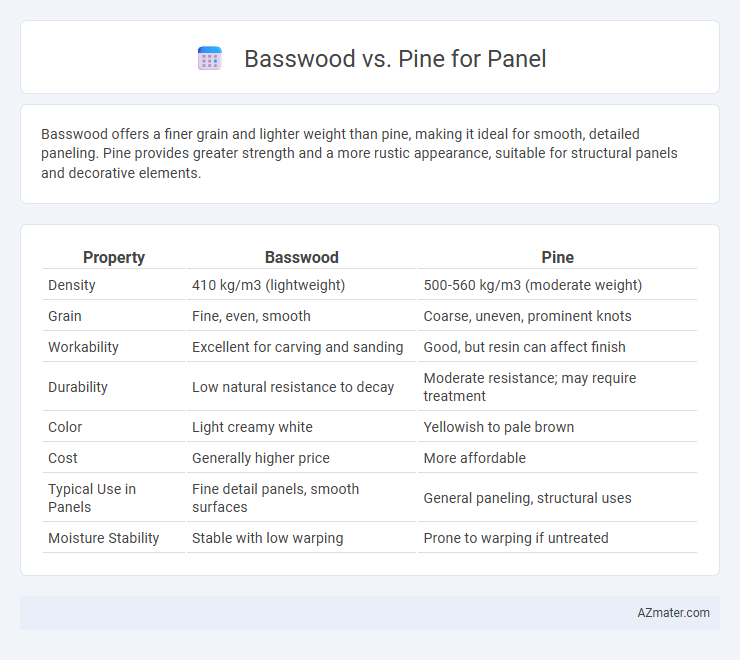Basswood offers a finer grain and lighter weight than pine, making it ideal for smooth, detailed paneling. Pine provides greater strength and a more rustic appearance, suitable for structural panels and decorative elements.
Table of Comparison
| Property | Basswood | Pine |
|---|---|---|
| Density | 410 kg/m3 (lightweight) | 500-560 kg/m3 (moderate weight) |
| Grain | Fine, even, smooth | Coarse, uneven, prominent knots |
| Workability | Excellent for carving and sanding | Good, but resin can affect finish |
| Durability | Low natural resistance to decay | Moderate resistance; may require treatment |
| Color | Light creamy white | Yellowish to pale brown |
| Cost | Generally higher price | More affordable |
| Typical Use in Panels | Fine detail panels, smooth surfaces | General paneling, structural uses |
| Moisture Stability | Stable with low warping | Prone to warping if untreated |
Introduction to Basswood and Pine Panels
Basswood panels offer a fine, even grain with a smooth texture, making them ideal for detailed carving and painting, commonly used in crafts and fine woodworking. Pine panels feature a prominent grain pattern and a softer texture that provides strength and affordability, widely favored for furniture and construction applications. Both woods serve distinct purposes, with basswood suited for precision work and pine preferred for structural versatility.
Wood Characteristics: Basswood vs Pine
Basswood features a fine, even grain with a smooth texture, making it ideal for detailed carving and painting due to its softness and light color. Pine, characterized by a more prominent grain and knots, has a softer, resin-rich composition that can cause uneven staining but offers greater strength for structural paneling. Basswood's low resin content and stability prevent warping, while pine's natural flexibility suits durable applications requiring impact resistance.
Appearance and Grain Comparison
Basswood panels showcase a fine, uniform grain with a pale, creamy hue that provides a smooth and elegant appearance ideal for painting and detailed carving. Pine panels feature a more pronounced grain with visible knots, varying from light yellow to amber tones, lending a rustic and textured look that enhances natural wood character. The choice between basswood and pine hinges on desired aesthetic effects, where basswood offers subtle refinement, and pine delivers warmth and visual interest through its grain patterns.
Workability and Machinability
Basswood offers superior workability and machinability compared to pine, making it ideal for detailed panel work and fine woodworking projects. Its fine, even texture and softness allow for smooth cutting, sanding, and carving without splintering. Pine, though easier to source and generally less expensive, is softer and prone to dents, which can affect precision in machining and detailed finishes.
Strength and Durability Factors
Basswood offers moderate strength with a fine, even grain that resists splitting, making it suitable for detailed panel work requiring smooth finishes. Pine features higher strength and natural resin content, providing enhanced durability and resistance to wear, ideal for structural panels exposed to stress. Basswood's softness enables easier machining, but pine's greater hardness and natural oils contribute to longer-lasting panels in demanding environments.
Cost Differences: Basswood vs Pine
Basswood panels generally cost more than pine due to their finer grain, smoother finish, and superior workability, making them preferred for detailed woodworking projects. Pine is typically less expensive because it is more abundant and grows faster, resulting in lower production and material costs. The choice between basswood and pine panels often depends on budget constraints and the desired quality and appearance of the finished product.
Suitability for Staining and Finishing
Basswood offers a fine, even grain that absorbs stains and finishes uniformly, making it ideal for achieving smooth, consistent color without blotching. Pine's pronounced grain and resin content can cause uneven stain absorption, often resulting in a patchy or blotchy appearance unless properly pre-treated with conditioners. For paneling projects requiring high-quality staining and finishing, basswood provides superior surface preparation and a more professional, durable finish compared to pine.
Environmental Impact and Sustainability
Basswood offers a more sustainable option for paneling due to its faster growth rate and ability to regenerate quickly, reducing deforestation pressure compared to Pine. Pine, while abundant, often requires more intensive management and longer growth cycles, which can contribute to habitat disruption and higher carbon emissions. Choosing basswood can lead to lower environmental impact, as it typically involves less chemical treatment and energy consumption throughout harvesting and processing.
Popular Applications in Panel Projects
Basswood is favored for panel projects requiring smooth carving surfaces and fine detail work, making it popular in intricate cabinetry, musical instruments, and decorative wall panels. Pine, known for its strength and affordability, is widely used in structural paneling, flooring, and rustic furniture, providing durability in heavy-traffic and outdoor environments. Both woods offer distinct advantages in panel applications, with basswood suited for precision work and pine preferred for robust, budget-friendly solutions.
Choosing the Right Wood for Your Panels
Basswood offers a smooth, fine grain ideal for detailed carving and painting on panels, making it perfect for artistic applications. Pine provides a more rustic look with visible knots and a softer texture, suitable for decorative or structural panels where affordability is key. Selecting between basswood and pine depends on the desired finish, durability, and budget for your panel project.

Infographic: Basswood vs Pine for Panel
 azmater.com
azmater.com